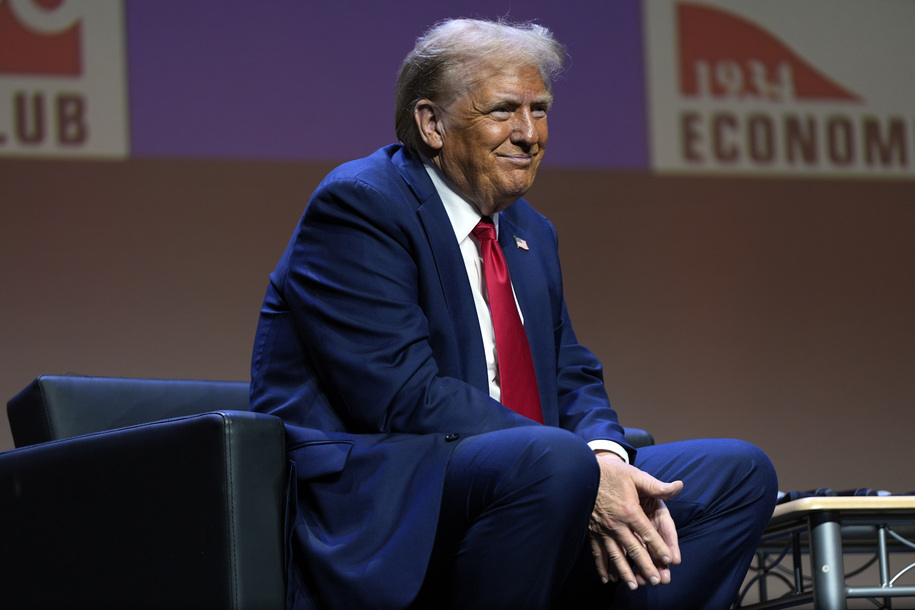Another day, another profoundly unserious economic proposal from Donald Trump. Thursday, Trump campaigned in Detroit, Michigan, where when he wasn’t busy insulting the city itself, he was tossing out a previously unannounced plan to make the interest on car loans tax-deductible.
This, of course, is nothing but pandering on Trump’s part, his lizard brain scrambling for something that would appeal to auto workers in a key swing state.
It’s telling that Trump didn’t propose anything that would directly change those workers’ lives for the better, such as improved safety protections or supporting strong unions as a bulwark against management. Instead, Trump, the man of the people, knows what auto workers crave: a tax break that would benefit rich people who buy expensive vehicles and would somehow magically trickle down to the workers who make those vehicles.
If this sort of thing sounds familiar, that’s because it is. When it comes to economic plans, Trump really has only one trick up his sleeve: tax relief. Well, he does have the whole “deporting millions will increase housing stock and therefore lower prices” idea, one that, besides being viciously racist, would tank the economy. Aside from that, all he’s got are vague ideas that tax credits and the like will somehow carry the election and save the economy.
It would be generous to call Trump’s car loan interest notion any more than a concept of a plan, but Trump is touting that it would “stimulate massive domestic auto production and make car ownership dramatically more affordable for millions and millions of working American families.” As one tax expert pointed out, this won’t help most people, as most Americans don’t itemize deductions as doing so isn’t typically greater than the standard deduction.
But you know who does itemize deductions? Rich people.
Ultimately, Trump’s idea is this: people will have so much spare cash from deducting car loan interest that they’ll buy new cars in droves, ushering in a renaissance of American car manufacturing. Since Trump has released no specifics on the plan, it’s anyone’s guess how this would happen.
Trump’s plan to fix the staggering cost of long-term home health care is similarly light on details. Trump was forced to come up with something in response to Vice President Kamala Harris’ plan to expand Medicare to cover home health care costs. Costs for in-home health care are currently beyond the reach of many. Having an aide come in 40 hours per week costs almost $69,000 per year, and round-the-clock services can exceed $288,000.
Home health care support would allow older adults to remain in their homes longer without resorting to a patchwork of unpaid care from family caregivers, many of whom have to quit their jobs to provide full-time care. The AARP estimates that caregivers provide $600 billion in unpaid care annually. A plan to cover these costs would be a game changer for millions.
So what would Trump do? Besides a substance-free statement that he would “take care of our seniors by shifting resources back to at-home senior care,” he would support “unpaid family caregivers through tax credits and reduced red tape.”
So, all the people who are currently trying to juggle their caregiving duties while also holding down a job and those who have had to quit a job to provide care will still have to do those things, but if they can white-knuckle it through another year, they’ll get to lower their tax bill.
Trump’s other economic proposals, which are less proposals and more a product of Trump pandering to whatever audience he is in front of, are similarly tied to his love of tax cuts. He’s proposed eliminating taxes on Americans who live abroad, but given that overseas workers who make less than $126,500 already don’t have to pay, this is just another gift to rich people.
He’s also proposed getting rid of taxes on tips, overtime, and Social Security. Even if one pretends he’s sincere about that, those moves would blow a hole in the federal budget. Estimates for the cost of Trump’s tax giveaways range from $8.5 trillion to $9.75 trillion over the next ten years. Trump would fund these cuts by imposing massive tariffs.
Even if one takes seriously the idea that the best plan for America is making consumer goods cost much more, the overall effects of this proposal benefit, of course, the rich. The Institute on Taxation and Economic Policy found that taxes would increase for all but the top 5% under Trump’s plan.
No one should be surprised that Trump, who managed to pay only $750 in income tax in 2017, despite reporting income of over $14 million that year, would fixate on tax abatement as What the People Really Want. However, regular folks can’t take advantage of the pro-business tax breaks that allow Trump to offset his considerable income with tax credits for his even more considerable business losses.
Nor did regular folks benefit from Trump’s massive 2017 tax cut, which made the extremely wealthy even more extremely wealthy but didn’t help the rest of us. A Harris presidency would instead focus on relief on issues affecting everyday Americans. In stark contrast, all a second Trump term guarantees is that the rich will get much, much richer.





